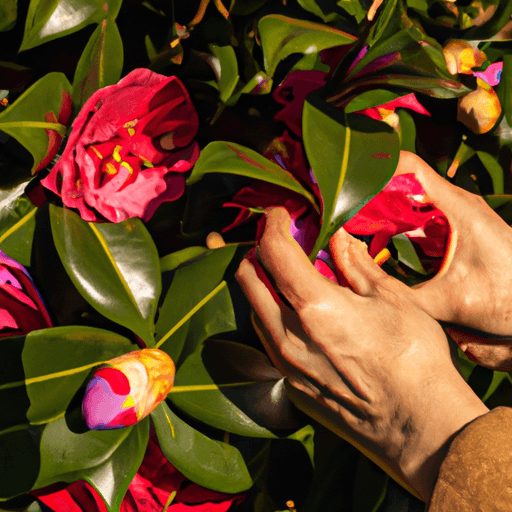Camellias, known for their stunning blooms, thrive in partial shade and well-drained soil. With a preference for consistently moist conditions, these plants require regular watering and benefit from a layer of mulch to maintain moisture levels.
Hardy in USDA zones 7 to 9, camellias can be propagated through layering or seeds, although the latter may take longer to mature. To ensure success, proper care, including regular fertilization and protection against common pests and diseases, is essential.
Discover the tips and techniques for growing and caring for camellias in this informative article.
Proper Growing Conditions for Camellias
Camellias thrive in partial shade or dappled sunlight. They should be planted in locations that receive dappled sunlight for the entire day.
Different camellia varieties have different climate preferences, so it’s important to choose the right one for your region. Camellia japonica cultivars are best suited for mild climates, while Camellia sasanqua cultivars can tolerate more sun and are suitable for warmer regions.
When planting camellias, consider companion plants that can complement their beauty. Some good companion plants for camellias include ferns, azaleas, rhododendrons, and hydrangeas. These plants have similar growing conditions and can create a stunning display when planted together.
Effective Propagation Techniques for Camellias
Propagation of camellias can be achieved through layering, where a stem is bent and buried to develop roots for a new plant. This method is more common and effective than propagation by seeds, as it can take a long time to grow mature plants from seeds.
To propagate through layering, gardeners can follow these steps:
- Select a healthy, flexible stem from the camellia plant.
- In the summer, make an angled nick in the stem and bend it down to the ground.
- Bury the wounded area in the soil, ensuring that it is in contact with the soil.
- Roots should develop from the wounded area within a few months.
- Once the roots have developed, the offspring can be clipped away from the parent plant and planted elsewhere.
Tips for Successful Container Growing of Camellias
To ensure successful container growing of camellias, gardeners should select large containers with adequate drainage holes and use rich, moisture-retentive potting soil. Choosing the right container is crucial for the health and growth of camellias. Large, wide, and heavy containers provide stability and room for the root system to develop. Adequate drainage holes prevent waterlogging and root rot.
Additionally, using a rich, moisture-retentive potting soil ensures that the camellias receive the necessary nutrients and retain moisture for optimal growth. In colder climates, protecting camellias in containers is essential. Insulating the soil and root system from freezing temperatures can be done by using dry leaves and pine straw to mound around the container. Furthermore, covering the pot and building a fence around it during extreme cold provide added protection.
Identifying and Managing Common Pests & Diseases in Camellias
Aphids, thrips, mealybugs, scale, and mites are common pests that gardeners must identify and manage in camellias. These pests can cause damage to the leaves, buds, and flowers of the plants, leading to stunted growth and reduced bloom.
To control these pests, gardeners can use horticultural oil like neem oil, which suffocates the insects and prevents them from reproducing. Regular monitoring of the plants and early intervention at the first signs of infestation is crucial for effective pest control.
In addition to pests, camellias are also susceptible to fungal diseases such as leaf spots, black mold, flower blight, canker, anthracnose, and root rot. To prevent these diseases, it is important to provide good air circulation, avoid over-watering, and apply fungicides early in the growing season.
Proper care and maintenance, including regular pruning and removing infected plant parts, can help keep camellias healthy and free from pests and diseases.
General Care Tips for Healthy Camellia Plants
Watering camellias twice a week and applying a three-inch layer of mulch are important for maintaining healthy camellia plants. Selecting the right location for winter survival is also crucial.
In addition to these general care tips, proper pruning techniques and winter protection measures are necessary for the well-being of camellias. Pruning should be done after the plant has finished blooming, typically in late spring or early summer. This involves removing dead or diseased branches and shaping the plant to maintain a desired form.
Winter protection measures are essential, especially in colder climates. This can include covering the plant with a frost cloth or burlap, mulching around the base to insulate the roots, and providing a windbreak to reduce the impact of cold winds.
Choosing the Right Fertilizer and Feeding Schedule for Camellias
Properly selecting the right fertilizer and establishing a feeding schedule is essential for promoting healthy growth and blooming in camellias. Here are three important considerations when choosing the right fertilizer types and understanding the nutrient requirements for camellias:
-
Nitrogen-rich slow-release fertilizer: Camellias thrive on nitrogen-rich fertilizers, which promote new growth and vibrant blooms. Look for fertilizers with a balanced ratio, such as 12-4-8 or 16-4-8, which provide the necessary nutrients for optimal growth.
-
Timing of fertilization: It’s important to fertilize camellias in early spring, late spring, and mid-summer. Avoid fertilizing after August to prevent damage from cold temperatures. Applying fertilizer at the right time ensures that the new growth is not susceptible to cold damage.
-
Fertilizer designed for camellias or azaleas: Using a fertilizer specifically formulated for camellias or azaleas ensures that the acidity levels are suitable for these plants. Camellias prefer slightly acidic soil, so choosing the right fertilizer can help maintain the optimal pH balance for their nutrient uptake.
Understanding these factors and selecting the right fertilizer types will provide camellias with the necessary nutrients for healthy growth and abundant blooming.







